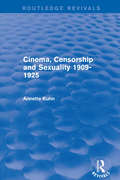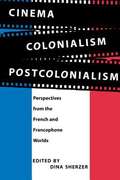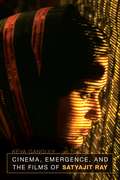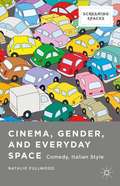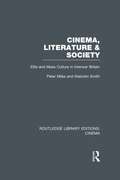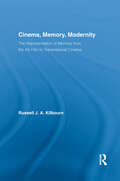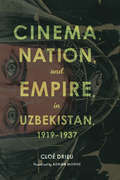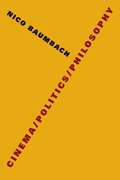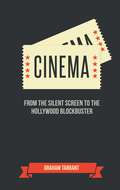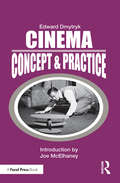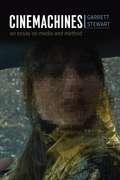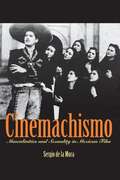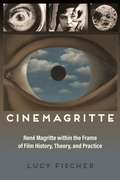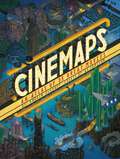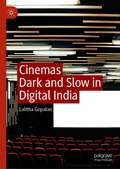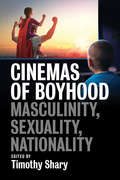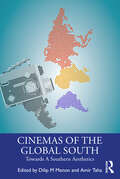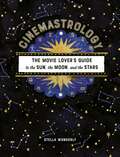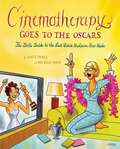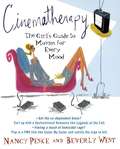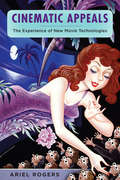- Table View
- List View
Cinema, Censorship and Sexuality 1909-1925 (Cinema And Society Ser.)
by Annette KuhnFirst published in 1988. This book shows how censorship as a set of institutions, practices and discourses was involved in the struggle over the nature of cinema in the early twentieth century. It also reveals the part played in this struggle by other institutions, practices and discourses — for example ‘new’ knowledge about sexuality and organisations devoted to the promotion of public morality. Instead of censorship simply being an act of prohibition by a special institution, this work reveals the issues at work were far more complex and contradictory — opening up critical scrutiny and challenging assumptions. This title will be of interest to students of media and film studies.
Cinema, Colonialism, Postcolonialism: Perspectives from the French and Francophone Worlds
by Dina SherzerThrough an examination of France and its colonies, multiethnic contemporary France, and cinematic discourses which have been and are being produced about France's colonial past, these authors explore how the images relay underlying assumptions and their relation to historical and political facts. A variety of subjects and viewpoints inform these studies, which cover the entire range of films on that topic.
Cinema, Emergence, and the Films of Satyajit Ray
by Keya GangulyThe book shows how Satyajit Ray, a renowned Indian filmmaker, redefines the grammar of cinema to make possible a vision of society unavailable in the novel or theater and documents the capacity of the image to conceptualize a different world.
Cinema, Gender, And Everyday Space
by Natalie FullwoodCommedia all'italiana, or Comedy, Italian style, became popular at a time of great social change. This book, utilizing comedies produced in Italy from 1958-70, examines the genre's representation of gender in the everyday spaces of beaches and nightclubs, offices, cars, and kitchens, through the exploration of key spatial motifs.
Cinema, Literature & Society: Elite and Mass Culture in Interwar Britain (Routledge Library Editions: Cinema)
by Malcolm Smith Peter MilesDuring the interwar period cinema and literature seemed to be at odds with each other, part of the continuing struggle between mass and elite culture which so worried writers such as Aldous Huxley, T.S. Eliot and the Leavises. And this cultural divide appeared to be sharp evidence of a deeper struggle for control of the nation’s consciousness, not only between dominant and oppositional elements within Britain, but between British and American vales as well. On the one hand, films like Sing As We Go, Proud Valley, and The Stars Look Down consolidated the assumptions about the existence of a national rather than separate class identities. On the other hand, working-class literature such as Love on the Dole articulated working-class experience in a manner intended to bridge the gap between the ‘Two Englands’. This book, originally published in 1987, examines how two of the most significant cultural forms in Britain contributed indirectly to the stability of Britain in the interwar crisis, helping to construct a new class alliance. A major element in the investigation is an analysis of the mechanics of the development of a national cultural identity, alongside separate working-class culture, the development of the lower-middle class and the implications of the intrusion of Hollywood culture. The treatment throughout is thematic rather than text-oriented – works of Graham Greene, George Orwell, Bert Coombes, Evelyn Waugh, the British Documentary Film Movement and Michael Balcon are included in the wide range of material covered.
Cinema, Memory, Modernity: The Representation of Memory from the Art Film to Transnational Cinema (Routledge Advances in Film Studies #6)
by Russell J.A. KilbournSince its inception, cinema has evolved into not merely a ‘reflection’ but an indispensable index of human experience – especially our experience of time’s passage, of the present moment, and, most importantly perhaps, of the past, in both collective and individual terms. In this volume, Kilbourn provides a comparative theorization of the representation of memory in both mainstream Hollywood and international art cinema within an increasingly transnational context of production and reception. Focusing on European, North and South American, and Asian films, Kilbourn reads cinema as providing the viewer with not only the content and form of memory, but also with its own directions for use: the required codes and conventions for understanding and implementing this crucial prosthetic technology — an art of memory for the twentieth-century and beyond.
Cinema, Nation, and Empire in Uzbekistan, 1919-1937
by Cloé DrieuBetween the founding of Soviet Uzbekistan in 1924 and the Stalinist Terror of the late 1930s, a nationalist cinema emerged in Uzbekistan giving rise to the first wave of national film production and an Uzbek cinematographic elite. In Cinema, Nation, and Empire in Uzbekistan Cloé Drieu uses Uzbek films as a lens to explore the creation of the Soviet State in Central Asia, starting from the collapse of the Russian Empire up through the eve of WWII. Drieu argues that cinema provides a perfect angle for viewing the complex history of domination, nationalism, and empire (here used to denote the centralization of power) within the Soviet sphere. By exploring all of film’s dimensions as a socio-political phenomenon—including film production, film reception, and filmic discourse—Drieu reveals how nation and empire were built up as institutional realities and as imaginary constructs. Based on archival research in the Uzbek and Russian State Archives and on in-depth analyses of 14 feature-length films, Drieu’s work examines the lively debates within the totalitarian and so-called revisionist schools that invigorated Soviet historiography, positioning itself within contemporary discussions about the processes of state- and nation-building, and the emergence of nationalism more generally. Revised and expanded from the original French, Cinema, Nation, and Empire in Uzbekistan helps us to understand how Central Asia, formerly part of the Russian Empire, was decolonized, but later, in the run-up to the Stalinist period and repression of the late 1930s, suffered a new style of domination.
Cinema, Nation, and Empire in Uzbekistan, 1919–1937
by Cloé DrieuThis study examines the creation of the Soviet State in Central Asia through the lens of Uzbek cinema—from the collapse of the Russian Empire to WWII.Between the founding of Soviet Uzbekistan in 1924 and the Stalinist Terror of the late 1930s, a nationalist cinema emerged. In Cinema, Nation, and Empire in Uzbekistan Cloé Drieu argues that the Uzbek films of this period provide a perfect angle for viewing the complex history of domination, nationalism, and empire building within the Soviet sphere. By exploring all of film’s dimensions—including production, reception, and discourse—Drieu reveals how nation and empire were built up as institutional realities and as imaginary constructs.Combining research in the Uzbek and Russian State Archives and in-depth analyses of fourteen films, Drieu’s work examines the debates within the totalitarian and so-called revisionist schools that invigorated Soviet historiography. Revised and expanded from the original French, Cinema, Nation, and Empire in Uzbekistan helps us to understand how Central Asia, formerly part of the Russian Empire, was decolonized, only to suffer a new style of domination in the run-up to the Stalinist period and repression of the late 1930s.
Cinema/Politics/Philosophy (Film and Culture Series)
by Nico BaumbachAlmost fifty years ago, Jean-Louis Comolli and Jean Narboni published the manifesto “Cinema/Ideology/Criticism,” helping to set the agenda for a generation of film theory that used cinema as a means of critiquing capitalist ideology. In recent decades, film studies has moved away from politicized theory, abandoning the productive ways in which theory understands the relationship between cinema, politics, and art. In Cinema/Politics/Philosophy, Nico Baumbach revisits the much-maligned tradition of seventies film theory to reconsider: What does it mean to call cinema political?In this concise and provocative book, Baumbach argues that we need a new philosophical approach that sees cinema as both a mode of thought and a form of politics. Through close readings of the writings on cinema by the contemporary continental philosophers Jacques Rancière, Alain Badiou, and Giorgio Agamben, he asks us to rethink both the legacy of ideology critique and Deleuzian film-philosophy. He explores how cinema can condition philosophy through its own means, challenging received ideas about what is seeable, sayable, and doable. Cinema/Politics/Philosophy offers fundamental new ways to think about cinema as thought, art, and politics.
Cinema: From the Silent Screen to the Hollywood Blockbuster
by Graham TarrantThis fascinating miscellany is packed with profiles of the heroes and villains of film, explorations of genre, statistics and infographics -perfect for any movie buff who loves the silver screen.
Cinema: From the Silent Screen to the Hollywood Blockbuster
by Graham TarrantThis fascinating miscellany is packed with profiles of the heroes and villains of film, explorations of genre, statistics and infographics -perfect for any movie buff who loves the silver screen.
Cinema: Themes And Variations (Edward Dmytryk: On Filmmaking)
by Edward DmytrykIn this unique study of the process of filmmaking, director Edward Dmytryk blends abstract film theory and the practical realities of feature film production to provide an artful and elegant analysis of the conceptual foundations of filmmaking and film studies. Dmytryk explores the technical principles underlying the craft of filmmaking and how their use is effective in developing the viewer’s involvement in the cinematic narrative. Originally published in 1988, this reissue of Dmytryk’s classic book includes a new critical introduction by Joe McElhaney.
Cinemachines: An Essay on Media and Method
by Garrett StewartThe hero stands on stage in high-definition 3-D while doubled on a crude pixel screen in Billy Lynn’s Long Halftime Walk. Alien ships leave Earth by dissolving at the conclusion of Arrival. An illusory death spiral in Vertigo transitions abruptly to a studio set, jolting the spectator. These are a few of the startling visual moments that Garrett Stewart examines in Cinemachines, a compelling, powerful, and witty book about the cultural and mechanical apparatuses that underlie modern cinema. Engaging in fresh ways with revelatory special effects in the history of cinematic storytelling—from Buster Keaton’s breaching of the film screen in Sherlock Jr. to the pixel disintegration of a remotely projected hologram in Blade Runner 2049—Stewart’s book puts unprecedented emphasis on technique in moving image narrative. Complicating and revising the discourse on historical screen processes, Cinemachines will be crucial reading for anyone interested in the evolution of the movies from a celluloid to a digital medium.
Cinemachismo: Masculinities and Sexuality in Mexican Film
by De La Mora SergioHe focuses on three traditional genres (the revolutionary melodrama, the cabaretera [dancehall] prostitution melodrama, and the musical comedy "buddy movie") and one subgenre (the fichera brothel-cabaret comedy) of classic and contemporary cinema. By concentrating on the changing conventions of these genres, de la Mora reveals how Mexican films have both supported and subverted traditional heterosexual norms of Mexican national identity. In particular, his analyses of Mexican cinematic icons Pedro Infante and Gael García Bernal and of Arturo Ripstein's cult film El lugar sin límites illuminate cinema's role in fostering distinct figurations of masculinity, queer spectatorship, and gay male representations. De la Mora completes this exciting interdisciplinary study with an in-depth look at how the Mexican state brought about structural changes in the film industry between 1989 and 1994 through the work of the Mexican Film Institute (IMCINE), paving the way for a renaissance in the national cinema.
Cinemagritte: René Magritte within the Frame of Film History, Theory, and Practice (Contemporary Approaches to Film and Media Series)
by Lucy FischerCinemagritte: René Magritte within the Frame of Film History, Theory, and Practice investigates the dynamic relationship between the Surrealist modernist artist René Magritte (1898–1967) and the cinema—a topic largely ignored in the annals of film and art criticism. Magritte once said that he used cinema as "a trampoline for the imagination," but here author Lucy Fischer reverses that process by using Magritte’s work as a stimulus for an imaginative examination of film. While Fischer considers direct influences of film on Magritte and Magritte on film, she concentrates primarily on "resonances" of Magritte’s work in international cinema—both fiction and documentary, mainstream and experimental. These resonances exist for several reasons. First, Magritte was a lover of cinema and created works as homages to the medium, such as Blue Cinema (1925), which immortalized his childhood movie theater. Second, Magritte’s style, though dependent on bizarre juxtapositions, was characterized by surface realism—which ties it to the nature of the photographic and cinematic image. Third, Magritte shares with film a focus on certain significant concepts: the frame, voyeurism, illusionism, the relation between word and image, the face, montage, variable scale, and flexible point of view. Additionally, the volume explores art documentaries concerning Magritte as well as the artist’s whimsical amateur "home movies," made with his wife, Georgette, friends, and Belgian Surrealist associates. The monograph is richly illustrated with images of Magritte’s oeuvre as well as film stills from such diverse works as The Eternal Sunshine of the Spotless Mind, Eyes Without a Face, American Splendor, The Blood of a Poet, Zorns Lemma, The Island of Dr. Moreau, The Draughtsman’s Contract, and many more. Cinemagritte brings a novel and creative approach to the work of Magritte and both film and art criticism. Students, scholars, and fans of art history and film will enjoy this thoughtful marriage of the two.
Cinemal: The Becoming-Animal of Experimental Film (Art After Nature)
by Tessa LairdA foray through the wilds where experimental films and animals collide Like the flash of a tropical bird&’s iridescent wing, cinema can be furtive and intensely beautiful—and it can leave a viewer craving more. Cinemal is Tessa Laird&’s passionate inquiry into the ways that films mimic the majesty, mystery, and movements of animals,her field notes from countless hair-raising encounters with films in their natural habitat. Part of a growing focus on nonhuman animals in film, Cinemal ventures to the &“furry underbelly&” of global experimental film practice, focusing on films from New Zealand, Australia, and South America. Laird examines how animals are depicted in film and analyzes the various animal qualities of cinema, like scratching and sniffing, vibrant colors, and voices (barking, howling, or echolocation). Burrowing into the work of filmmakers such as Arthur and Corinne Cantrill, Sriwhana Spong, and Ana Vaz, Laird&’s energetic prose embodies the films she discusses, seamlessly combining personal anecdotes with art theory and philosophy to spread a wide sensory buffet. Lively and optimistic, Laird uses cinematic animal tropes to encourage readers to rethink what it means to be human. She argues that, in a time of ecological collapse, such an impulse is a necessary means of imagining other, healthier ways of being in this world. Connecting us with the more-than-human, Cinemal lures us toward the beastly becomings of film and, ultimately, our own animal natures. Retail e-book files for this title are screen-reader friendly.
Cinemaps: An Atlas of 35 Great Movies
by Andrew Degraff A. D. JamesonThis beautifully illustrated atlas of beloved movies is an essential reference for cinephiles, fans of great films, and anyone who loves the art of mapmaking. Acclaimed artist Andrew DeGraff has created beautiful hand-painted maps of all your favorite films, from King Kong and North by Northwest to The Princess Bride, Fargo, Pulp Fiction, even The Breakfast Club—with the routes of major characters charted in meticulous cartographic detail. Follow Marty McFly through the Hill Valley of 1985, 1955, and 1985 once again as he races Back to the Future. Trail Jack Torrance as he navigates the corridors of the Overlook Hotel in The Shining. And join Indiana Jones on a globe-spanning journey from Nepal to Cairo to London on his quest for the famed Lost Ark. Each map is presented in an 11-by-14-inch format, with key details enlarged for closer inspection, and is accompanied by illuminating essays from film critic A. D. Jameson, who speaks to the unique geographies of each film.
Cinemas Dark and Slow in Digital India
by Lalitha GopalanThis book provides a sustained engagement with contemporary Indian feature films from outside the mainstream, including Aaranaya Kaandam, I.D., Kaul, Chauthi Koot, Cosmic Sex, and Gaali Beeja, to undercut the dominance of Bollywood focused film studies. Gopalan assembles films from Bangalore, Chennai, Delhi, Kolkata, and Trivandrum, in addition to independent productions in Bombay cinema, as a way of privileging understudied works that deserve critical attention. The book uses close readings of films and a deep investigation of film style to draw attention to the advent of digital technologies while remaining fully cognizant of ‘the digital’ as a cryptic formulation for considering the sea change in the global circulation of film and finance. This dual focus on both the techno-material conditions of Indian cinema and the film narrative offers a fulsome picture of changing narratives and shifting genres and styles.
Cinemas of Boyhood: Masculinity, Sexuality, Nationality
by Timothy SharyDrawing from political sociology, pop psychology, and film studies, Cinemas of Boyhood explores the important yet often overlooked subject of boys and boyhood in film. This collected volume features an eclectic range of films from British and Indian cinemas to silent Hollywood and the new Hollywood of the 1980s, culminating in a comprehensive overview of the diverse concerns surrounding representations of boyhood in film.
Cinemas of the Global South: Towards a Southern Aesthetics
by Amir Taha Dilip M MenonThis book engages with the idea of the Global South through cinema as a concept of resistance; as a space of decolonialisation; and as an arena of virtuality, creativity and change. It opens up a dialogue amongst scholars and filmmakers from the Global South: India, Nigeria, Colombia, Brazil, South Africa, and Egypt.The essays in the volume approach cinema as an intertwined process of both production and perception not divorced from the economic, social, political and cultural. They emphasise film as a visual medium where form, structure and content are not separable. Through a wide array of film-readings, the authors explore the concept of a southern cinematic esthetics, in particular, and the concept of the Global South in general.The volume will be of interest to scholars, students and researchers of film and media studies, critical theory, cultural studies and Global South studies.
Cinemastrology: The Movie Lover's Guide to the Sun, the Moon, and the Stars
by Stella WonderlyPicking your perfect flick can be an overwhelming experience. But fear not! Cinemastrology answers a question that has stumped even the most avid film buff for over a century: "What movie should I watch?"From contemporary comedies to Hollywood classics, from date movies to adrenaline fests, Cinemastrology is your guide to the art of selecting viewing based on your astrological sign. It includes profiles of all the sun signs and offers an extensive list of movie recommendations for each, complete with descriptions, behind-the-scenes stories, and insights into the unique qualities of each sign, from Aries to Pisces. Sections covering the stars that light up the screen and sign-compatible suggestions based on the sign of your partner or film-viewing friend round out Cinemastrology.Getting started is easy! All you need is a birthday and a passion for movies.
Cinematherapy Goes to the Oscars
by Beverly West Nancy PeskeGet ready for some of the best movie medicine ever made. The smash hit women's film guide Cinematherapy taught women that comfort, self-acceptance, inspiration, and humor were no farther away than the video store - and inspired the daily prime-time show on the WE Network (Women's Entertainment). Now the authors are back with a Cinematherapy take on the Oscar canon and how these award-winning films serve not only as a celluloid pharmacy but also as a window into ourselves, our relationships, and our times. Starting with the present and working backward by decade, Cinematherapy Goes to the Oscars uncovers the grand themes of each decade's award-winning films, from the Father Issue films of the seventies, with their ambiguous father figures (Patton, Kramer vs. Kramer) to bad girls acting out for disapproving fathers' love (Klute, Cabaret), to the Unsung Hero films of the fifties (On the Waterfront, The African Queen). Along the way there is great dish on who wore what on the Red Carpet, who said what in their acceptance speeches, and party tips for throwing a four-star Oscar bash, as well as returning popular sidebars like the Handy Hunk Chart. As the first female take on these sacred cows of the Silver Screen, focusing on the moments, messages, leading ladies, and supporting men that matter to us most, Cinematherapy Goes to the Oscars is the ultimate indulgence for every woman ready to curl up and take charge of her own remote control.
Cinematherapy: The Girl's Guide to Movies For Every Mood
by Beverly West Nancy PeskeWhat can take the edge off a bad day at the office better than a movie where the boss gets his (9-5)? And, of course, that close-up of Antonio Banderas, wet and naked in a cage, is the best cure for the break-up blahs known to modern science (Never Talk to Strangers). Now, for the first time, Cinematherapy acknowledges what women have known for years, and provides a sage guide to the best movie medicine currently available for whatever ails you, whether it's a sudden hormonal shift, a bad-hair day, or a full-fledged identity crisis.
Cinematic Appeals
by Ariel RogersCinematic Appeals follows the effect of technological innovation on the cinema experience, specifically the introduction of widescreen and stereoscopic 3D systems in the 1950s, the rise of digital cinema in the 1990s, and the transition to digital 3D since 2005. Widescreen films drew the spectator into the world of the screen, enabling larger-than-life close-ups of already larger-than-life actors. The technology fostered the illusion of physically entering a film, enhancing the semblance of realism. Alternatively, the digital era was less concerned with manipulating the viewer's physical response and more with generating information flow, awe, disorientation, and the disintegration of spatial boundaries. This study ultimately shows how cinematic technology and the human experience shape and respond to each other over time. Films discussed include Elia Kazan's East of Eden (1955), Star Wars: Phantom Menace (1999), The Matrix (1999), and Thomas Vinterberg's Dogme film Celebration (1995).
Cinematic Appeals: The Experience of New Movie Technologies (Film and Culture Series)
by Ariel RogersCinematic Appeals follows the effect of technological innovation on the cinema experience, specifically the introduction of widescreen and stereoscopic 3D systems in the 1950s, the rise of digital cinema in the 1990s, and the transition to digital 3D since 2005. Widescreen cinema promised to draw the viewer into the world of the screen, enabling larger-than-life close-ups of already larger-than-life actors. This technology fostered the illusion of physically entering a film, enhancing the semblance of realism. Alternatively, the digital era was less concerned with the viewer's physical response and more with information flow, awe, and the reevaluation of spatiality and embodiment. This study ultimately shows how cinematic technology and the human experience shape and respond to each other over time.
